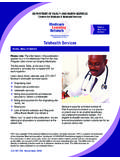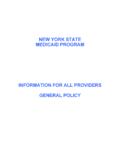Transcription of OSHA 3148-06R 2016 www.osha
1 A c e g p Preventin workio ence n e s f o r Guideli v hcare for Healt Service ial and Soc Workers wDepartment Labor ov OSHA 3148-06R 2016 Occupational Safety and Health Act of 1970. To assure safe and healthful working conditions for working men and women; by authorizing enforcement of the standards developed under the Act; by assisting and encouraging the States in their efforts to assure safe and healthful working conditions; by providing for research, information, education, and training in the field of occupational safety and . This publication provides a general overview of worker rights under the Occupational Safety and Health Act (OSH Act).
2 This publication does not alter or determine compliance responsibilities which are set forth in OSHA standards and the OSH Act. Moreover, because interpretations and enforcement policy may change over time, for additional guidance on OSHA. compliance requirements the reader should consult current administrative interpretations and decisions by the Occupational Safety and Health Review Commission and the courts. Material contained in this publication is in the public domain and may be reproduced, fully or partially, without permission. Source credit is requested but not required. This information will be made available to sensory-impaired individuals upon request.
3 Voice phone: (202) 693-1999;. teletypewriter (TTY) number: 1-877-889-5627. Guidelines for Preventing Workplace Violence for Healthcare and social Service Workers Department of Labor Occupational Safety and Health Administration OSHA 3148-06R 2016. This guidance document is advisory in nature and informational in content. It is not a standard or regulation, and it neither creates new legal obligations nor alters existing obligations created by the Occupational Safety and Health Administration (OSHA) standards or the Occupational Safety and Health Act of 1970 (OSH Act or Act). Pursuant to the OSH Act, employers must comply with safety and health standards and regulations issued and enforced either by OSHA or by an OSHA-approved state plan.
4 In addition, the Act's General Duty Clause, Section 5(a)(1), requires employers to provide their workers with a workplace free from recognized hazards that are causing or likely to cause death or serious physical harm. In addition, Section 11(c)(1) of the Act provides that No person shall discharge or in any manner discriminate against any employee because such employee has filed any complaint or instituted or caused to be instituted any proceeding under or related to this Act or has testified or is about to testify in any such proceeding or because of the exercise by such employee on behalf of himself or others of any right afforded by this Act.
5 Reprisal or discrimination against an employee for reporting an incident or injury related to workplace violence, related to this guidance, to an employer or OSHA would constitute a violation of Section 11(c) of the Act. In addition, 29 CFR provides that Section 11(c) of the Act prohibits discrimination against an employee for reporting a work- related fatality, injury or illness. Table of Contents Overview of the Guidelines .. 1. Violence in the Workplace: The Impact of Workplace Violence on Healthcare and social Service Workers .. 2. Risk Factors: Identifying and Assessing Workplace Violence Hazards .. 3. Violence Prevention Programs.
6 5. 1. Management Commitment and Worker Participation.. 6. 2. Worksite Analysis and Hazard Identification .. 8. 3. Hazard Prevention and Control.. 12. 4. Safety and Health Training.. 24. 5. Recordkeeping and Program Evaluation.. 27. Workplace Violence Program Checklists.. 30. Bibliography.. 40. Workers' Rights .. 46. OSHA Assistance, services and Programs .. 46. NIOSH Health Hazard Evaluation Program .. 50. OSHA Regional Offices.. 51. How to Contact OSHA.. 53. Overview of the Guidelines Healthcare and social service workers face significant risks of job-related violence and it is OSHA's mission to help employers address these serious hazards.
7 This publication updates OSHA's 1996 and 2004 voluntary guidelines for preventing workplace violence for healthcare and social service workers. OSHA's violence prevention guidelines are based on industry best practices and feedback from stakeholders, and provide recommendations for developing policies and procedures to eliminate or reduce workplace violence in a range of healthcare and social service settings. These guidelines reflect the variations that exist in different settings and incorporate the latest and most effective ways to reduce the risk of violence in the workplace. Workplace setting determines not only the types of hazards that exist, but also the measures that will be available and appropriate to reduce or eliminate workplace violence hazards.
8 For the purpose of these guidelines, we have identified five different settings: Hospital settings represent large institutional medical facilities;. Residential Treatment settings include institutional facilities such as nursing homes, and other long-term care facilities;. Non-residential Treatment/Service settings include small neighborhood clinics and mental health centers;. Community Care settings include community-based residential facilities and group homes; and Field work settings include home healthcare workers or social workers who make home visits. Indeed, these guidelines are intended to cover a broad spectrum of workers, including those in: psychiatric facilities, hospital emergency departments, community mental health clinics, drug abuse treatment centers, pharmacies, community-care centers, and long-term care facilities.
9 Healthcare and social service workers covered by these guidelines include: registered nurses, nurses' aides, therapists, technicians, home healthcare workers, Guidelines for Preventing Workplace Violence for Healthcare and social Service Workers 1. social workers, emergency medical care personnel, physicians, pharmacists, physicians' assistants, nurse practitioners, and other support staff who come in contact with clients with known histories of violence. Employers should use these guidelines to develop appropriate workplace violence prevention programs, engaging workers to ensure their perspective is recognized and their needs are incorporated into the program.
10 Violence in the Workplace: The Impact of Workplace Violence on Healthcare and social Service Workers Healthcare and social service workers face a significant risk of job-related violence. The National Institute for Occupational Safety and Health (NIOSH) defines workplace violence as violent acts (including physical assaults and threats of assaults) directed toward persons at work or on duty. 1. According to the Bureau of Labor Statistics (BLS), 27 out of the 100 fatalities in healthcare and social service settings that occurred in 2013 were due to assaults and violent acts. While media attention tends to focus on reports of workplace homicides, the vast majority of workplace violence incidents result in non-fatal, yet serious injuries.
















